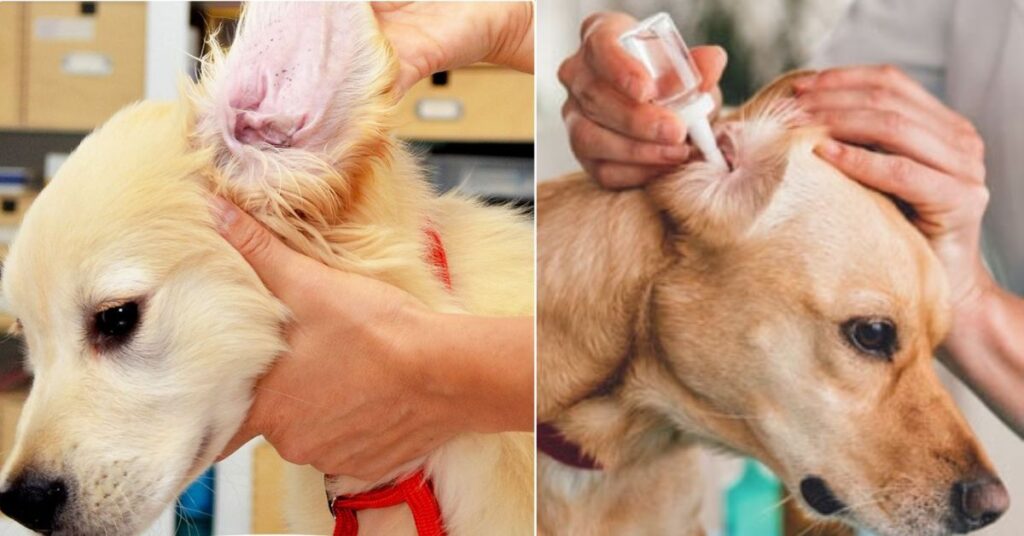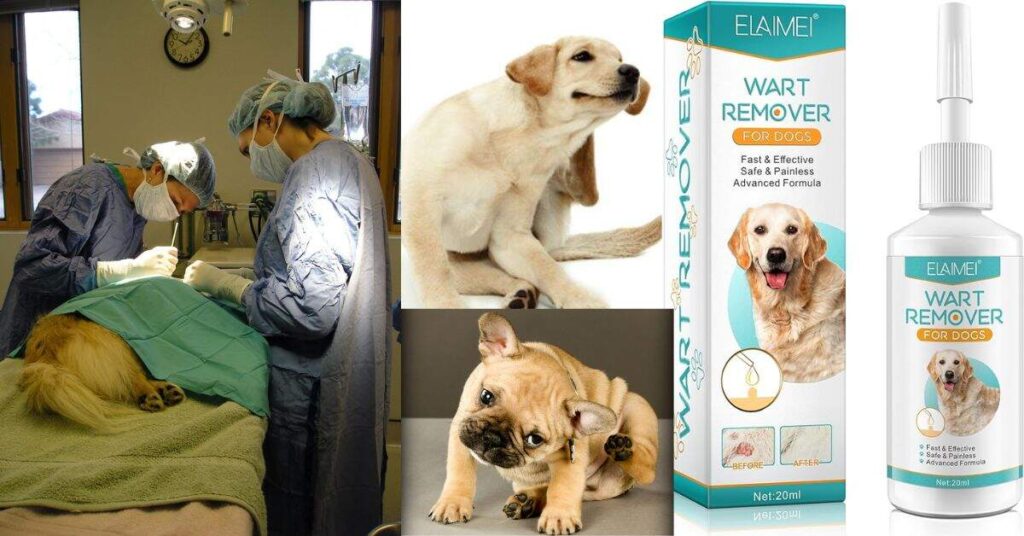Ear hematomas in dogs can be a concerning and painful condition that requires prompt attention. These swollen pockets of blood within the ear flap can arise from various factors, such as excessive head shaking, trauma, or underlying ear infections.
Recognizing the signs early and understanding the appropriate treatment options are crucial for a successful recovery. Whether through home remedies or professional veterinary care, addressing dog ear hematomas promptly can prevent further complications and restore your furry companion’s comfort.
Dog Ear Hematomas: Signs, Treatment & Prevention

Ear hematomas in dogs are one of the most common aural injuries, affecting millions of pups each year. But what exactly is an ear hematoma? Simply put, it’s a painful swelling that occurs when blood vessels rupture and leak blood into the flap of the ear.
Ranging from a small, soft swelling to a large, fluid filled pocket, these unsightly “cauliflower ears” can cause significant discomfort and may require veterinary intervention to resolve. In this comprehensive guide, we’ll dive into the causes, symptoms, treatment options, and prevention tips for dog ear hematomas.
What Causes Ear Hematomas In Dogs?

Several underlying factors can trigger the formation of an aural hematoma in dogs:
- Head shaking due to ear infections, allergies, or irritation
- Trauma or injury to the ear flap from scratching, grooming, or accidents
- Ear mites, bacteria, or yeast overgrowth leading to infection and inflammation
Essentially, any condition that causes excessive head shaking, scratching, or irritation to the ear can increase blood flow and pressure, making the thin blood vessels more prone to rupturing.
Which Dogs Are More Prone To Ear Hematomas?
While any dog can potentially develop an ear hematoma, certain breeds and characteristics put some pups at higher risk:
- Floppy or pendulous ear types: Such as Basset Hounds, Bloodhounds, and Cocker Spaniels
- Dogs with allergies: Environmental or food allergies often manifest as ear irritation
- Thick, heavy ear leather: Breeds like Bulldogs and Boxers have thicker ear flaps
- Previous ear infections or hematomas: Increasing overall risk
The dogs that spend more time swimming or in humid environments may also be more susceptible due to excess moisture buildup inside the ears.
Symptoms & Causes: How To Spot It
If your pup has developed an ear hematoma, you may notice obvious signs like:
- A swollen, discolored ear flap that’s warm to the touch
- Reluctance to shake their head or flatten their ears back
- Head tilting or increased sensitivity around the affected ear
As pet owner Samantha G. recalls,
“Rufus’ ear was so puffed up and purple-tinged, it looked like a small balloon!”
The swelling occurs because blood pools beneath the skin, creating a soft, squishy pocket. In some cases, you may even see visible bruising.
What Happens If A Hematoma Is Left Untreated?
While hematomas may start out small, leaving them untreated can lead to serious complications like:
- Infection: The pooled blood creates an ideal environment for bacterial growth
- Disfigurement: As blood and fluid accumulate, the swelling may become permanent
- Cauliflower ear: Scar tissue forms, giving the ear a wrinkled, deformed appearance
- Chronic pain and headtilting: From inflammation, pressure and potential infection
To prevent long-term issues, it’s crucial to have aural hematomas evaluated and properly treated, whether at home or by a veterinarian.
When To Worry About A Hematoma In Your Dog’s Ear Flap
While some very minor, small hematomas may resolve with home care, you should seek prompt veterinary treatment if your dog exhibits any of the following:
- Severe swelling that’s hot to the touch
- Bleeding, oozing or discharge from the ear
- Head shaking, ear scratching or other signs of pain
- Loss of appetite or lethargy
- Pre-existing conditions like clotting disorders
It’s always better to err on the side of caution with ear hematomas, as they can rapidly worsen and become more difficult to treat if left unchecked.
Read This Blog: What Does It Mean When Your Partner Pulls You Closer in Their Sleep?
Treatment Options
The appropriate treatment approach depends on the severity of the hematoma and whether any infection is present.
Home Treatments (for mild cases):
For very small, newly formed hematomas with no signs of injury or infection, your vet may first recommend trying one of these home remedies:
- Warm compresses: Applying a warm, damp cloth can help increase circulation and reabsorption of minor fluid buildup.
- Over-the-counter medications: Vet-approved doggie aspirin or anti-inflammatory can reduce swelling and pain. Always consult your vet for proper dosing.
- Head wraps: Gently wrapping and securing the ear flap can prevent further blood tracking into the area.
Steps to perform home treatment (if applicable)
If attempting home care, it’s crucial to do so safely and correctly:
- Restrain your dog calmly but firmly to avoid sudden head movements.
- Clean the area with a pet-safe solution to prevent infection.
- Apply a warm compress for 5-10 minutes, 2-3 times daily.
- Give any prescribed medication with food as directed.
- Wrap the ear flap using a soft, absorbent material like cotton wool or gauze. Be careful not to wrap too tightly.
- Use an Elizabethan collar to discourage scratching or head shaking while healing.
Carefully monitor your pup’s condition if the hematoma grows, becomes firmer, or any discharge appears, stop home treatment and consult your vet immediately.
Vet Treatments (for most cases):
In the majority of dog ear hematoma cases, veterinary intervention is typically required to resolve the condition and prevent complications. Common treatment methods include:
Surgical Drainage: The vet makes a small incision to fully drain the fluid and blood pocket. The empty cavity is then surgically closed or packed with absorbent material to encourage healing from the inside out.
Steroid Injections: Anti-inflammatory steroid medications can be injected directly into the hematoma to help reduce swelling and facilitate reabsorption of any remaining blood.
Systemic Medications: Oral antibiotics, steroids or anti-inflammatories may be prescribed alongside other treatments to combat infection and pain.
Studies show that dogs receiving prompt veterinary treatment for aural hematomas have a high success rate around 80%-90% make a full recovery.
According to Dr. Katrina Mealey, DVM at Washington State University:
“When caught and treated early, even large hematomas heal relatively quickly with proper intervention. However, the longer they go untreated, the higher the risk of the hematoma becoming permanent and infected.”
Conventional Treatments
One of the most effective ways vets treat dog ear hematomas is through surgical drainage and closure. Here’s a basic overview of the procedure:
- The dog receives general anesthesia or heavy sedation.
- The vet makes a linear incision across the hematoma to drain all the fluid and evacuate any remaining blood clots.
- The empty cavity is meticulously flushed out with sterile saline solution.
- Two common closure techniques:
- Quilting or mattress sutures: Places multiple everting sutures across the cavity to allow it to heal and close from within.
- Drainage tube placement: A sterile tube is inserted to facilitate continuous draining as healing occurs.
- The outer incision is closed with surgical sutures or staples.
Post-operative care usually involves oral antibiotics and anti-inflammatories, along with an Elizabethan collar to discourage ear interference. With proper treatment, most dogs make a full recovery within 2-3 weeks.
While effective, surgical treatment does come at a higher cost. Dog ear hematoma surgery typically runs $200-$800 depending on the case and geographic location.
Dog Ear Anatomy 101
Before we discuss prevention methods, it’s helpful to understand the basic anatomy of a dog’s ears and what makes them so prone to issues like hematomas and infections.
A dog’s ears consist of three main parts:
- Outer Ear: TheVisible part including the ear flap (pinna)
- Middle Ear: The air-filled cavity behind the eardrum
- Inner Ear: Housing the nerve receptors for hearing and balance
Insert Diagram of Dog Ear Anatomy
The pendulous, floppy shape of many dog breeds’ outer ears can actually work against them. Those cute, dangling ears provide the perfect environment for trapping moisture, dirt, bacteria and allergens that lead to inflammation and head shaking – often the first step toward hematoma development.
Common Causes of Ear Infections in Dogs

Since ear infections are often the underlying culprit behind hematoma formation, it’s important to understand some of the most common causes:
Environmental Allergens: Dust mites, pollen, mold and other indoor/outdoor allergens can irritate and inflame the delicate ear canal lining. This excessive inflammation causes dogs to shake their heads vigorously.
Ear Mites: Microscopic Otodectes cynotis mites can take up residence in a dog’s ears, causing severe itching. Their feces and shed skin casings also contribute to infection risk.
Bacterial or Yeast Overgrowth: Opportunistic microbial infections can occur when a dog’s ears don’t get properly cleaned and dried. Moisture buildup creates a breeding ground.
Foreign Bodies: Plant matter like grass seeds or sharp debris getting lodged in the ear canal triggers head shaking and trauma.
Excessive Moisture: Dogs who swim frequently or live in humid environments are more prone to recurrent, chronic ear issues from trapped water inside the ears.
This internal irritation, inflammation and infection then sets the stage for an aural hematoma to develop from all the excessive head trauma.
How to Safely Drain a Dog Ear Hematoma at Home

For small, minor hematomas with no sign of underlying infection or injury, vets may sometimes advise trying home draining techniques first. However, this should only be attempted with explicit veterinary guidance.
Here are the proper steps for safely draining a mild ear hematoma on your dog at home:
- Restrain Properly: Have someone gently hold and stabilize your dog’s head to prevent sudden jerking movements that could worsen the hematoma.
- Sterilize the Area: Carefully clean the outer ear flap with a pet-safe antimicrobial solution to disinfect the area.
- Drain the Fluid: Using a sterile 18-20 gauge needle or syringed without the needle attached, penetrate the swollen area and extract as much built-up fluid/blood as possible into the syringe chamber.
- Apply Pressure: Once drained, cover the area with a thick sterilized gauze and wrap it firmly with a stretchy cohesive bandage to allow the cavity to seal up.
- Monitor Closely: Check the bandage several times daily, replacing it if any fluid, blood or discharge seeps through. If swelling increases or your dog seems in pain, discontinue home treatment.
Here are some important safety notes for home hematoma draining:
- Only drain the ear once, do not repeatedly drain
- Never cut or make an incision into the swollen area
- Stop immediately if you encounter any resistance when penetrating
- Consider sedation or having your vet demonstrate the technique first
- Do not attempt if the hematoma is very large, firm, or your dog won’t settle
If done incorrectly, improper home draining can actually increase the risk of pain, scarring and introducing infection. It’s always safest to have a veterinarian properly treat the hematoma.
Surgical vs Non-Surgical Hematoma Treatments

For most cases of auricular hematomas in dogs, veterinary intervention is recommended to fully resolve the condition and facilitate proper healing. But what are the different treatment options?
Surgical Drainage and Closure
- Considered the best permanent fix for large, severe hematomas
- General anesthesia required for complete draining and surgical closure
- Allows the drained pocket to heal completely from the inside-out
- Higher cost ($200-$800+ depending on size/location)
- Extremely high success rate (90%) but requires homecare like e-collar
Steroid Injections
- Less invasive option suitable for some acute, non-recurring cases
- Vet injects a long-acting steroid solution directly into hematoma
- Helps reduce inflammation and facilitate reabsorption of remaining blood/fluid
- More economical than surgery (~$50-$200) with lower risks
- Around 50% success rate, may require repeat injections
- Not ideal for chronic/recurring cases or if infection present
Systemic Medications
- Often used as supplementary therapy alongside other treatments
- Oral antibiotics help prevent/combat infection if present
- Anti-inflammatories like steroids or NSAIDs help reduce swelling
- Pain medications for patient comfort during healing process
- Relatively low cost (~$25-$100 for full course)
The best treatment approach really depends on several factors including:
- Size, severity and stage of the hematoma
- Whether infection/discharge is present
- The dog’s overall health status
- Cost considerations for the owner
- Risk of hematoma re-occurring
Most veterinarians recommend surgical drainage as the optimal solution, especially for larger, long-standing hematomas. But some milder, acute cases may respond to more conservative steroid injection or medical management first.
Also Read this: What To Do If My Dog Ate Avocado? A comprehensive Guide:
Tips for Preventing Recurring Ear Hematomas
Even after resolving the initial hematoma incident, some dogs are prone to recurrences without proper preventative care. Follow these tips to reduce risk:
Keep Ears Clean and Dry
- Use a vet-approved ear cleaning solution weekly
- Thoroughly dry the ear canal after bathing or swimming
- Consider applying a drying, anti-microbial powder for dogs with chronic moisture issues
Discourage Head Shaking
- Resolve any underlying causes of ear irritation
- Use a snug headwrap or head cone temporarily after treatment
- Consider a properly fitted collar that prevents head shaking
Manage Allergies
- Dogs with environmental or food allergies are predisposed to ear issues
- Work with your vet on elimination diets, medications or immunotherapy
- Control environmental triggers through air filters, cleaning, etc.
Check Ears Regularly
- At least weekly, inspect deep in the ear canal for any redness, swelling or discharge
- Catching issues early can prevent hematoma development
Maintain Proper Hygiene
- Ensure ears are thoroughly cleaned and dried after grooming, bathing or swimming
- Keep hair trimmed around ear openings to allow good air flow
- Use only vet-approved ear cleaners, never insert Q-tips into the ear canal
With diligent ear care and management of any underlying conditions, many dogs with previous aural hematomas can avoid repeat episodes – giving them the happiest, healthiest ears possible!
For more guidance on ear hematoma prevention or other pet care questions, be sure to consult your trusted veterinarian. They can provide customized advice for your furry friend’s needs.
I hope this comprehensive guide has provided all the details you need on dog ear hematomas – from identifying the signs and causes to understanding your full treatment options and prevention strategies. Let me know if you have any other questions!
Dog Ear Hematoma High Risk Breeds
While any dog can potentially develop an ear hematoma, certain breeds with pendulous, floppy ears and/or documented allergies seem to be at higher risk. These include:
Basset Hounds With their long, hanging ears covering the ear canal, Basset Hounds top the list for ear issues. Their heavy ears also create an ideal environment for trapping moisture.
Cocker Spaniels The long fur and floppy ears of this popular breed make them prone to ear infections that can lead to head shaking and hematomas if not properly treated.
Bulldog Breeds English Bulldogs, French Bulldogs and others of the brachycephalic group frequently suffer from ear ailments due to their thick, heavy ear leather and allergies.
Bloodhounds The excessive skin and long, drooping ears of the Bloodhound allow debris and moisture to easily accumulate in the ear canal.
Golden Retrievers This breed’s floppy ears combined with their well-documented struggles with allergies and skin irritation put them at higher risk as well.
Other breeds like Shar Peis, Weimaraners, Boxers and any type of hound dog with big, floppy ears should have their ears checked regularly for early signs of issues.
Conclusion
Treating a dog ear hematoma requires a combination of patience, diligence, and often, professional veterinary assistance. While home remedies may provide temporary relief for mild cases, seeking expert guidance ensures a comprehensive approach tailored to your dog’s specific needs.
By being proactive in identifying and addressing the underlying causes, you can not only resolve the current hematoma but also prevent future recurrences. With proper care and attention, your faithful canine companion can once again enjoy healthy, hematoma-free ears, allowing them to live their life to the fullest.







